Holly Jolly
Our region is steeped in holly history, as American holly is native to the Atlantic coastal plain.
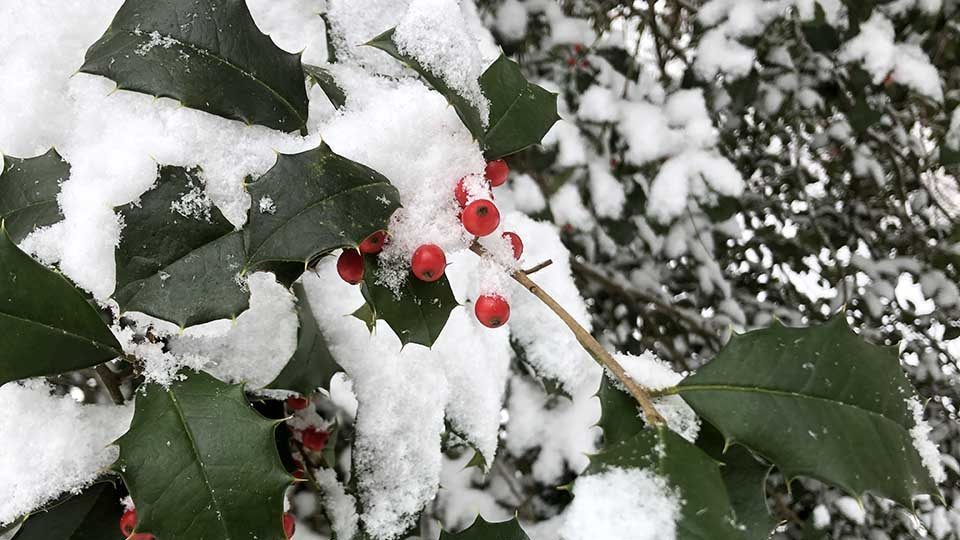
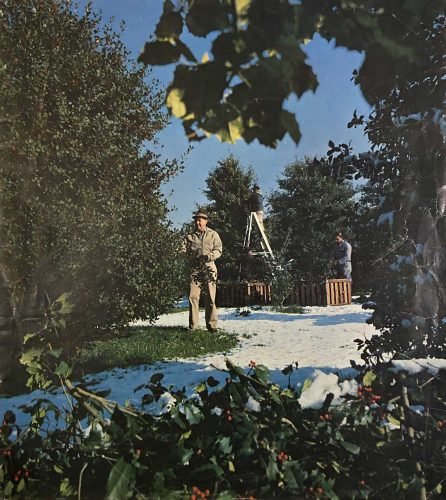
Southern New Jersey residents get to enjoy holly year-round in our wooded areas, but at Christmastime I’m especially appreciative of it as it adds color to what otherwise would be a more barren landscape. For centuries holly has been synonymous with the Christmas holiday, if for no better reason than its deep green leaves and red berries. But the Christmas ties actually come from cultures that pre-date Christ.
Romans celebrated Saturn with the Saturnalia festival, linked to the god of harvest and agriculture. The Saturnalia festivities are thought to be the beginning of Druids in France and Britain using holly in their solstice celebrations by hanging it in doorways. Celtic Druid priests believed holly warded off evil spirits. Conversely Germanic custom held that it would act as a refuge for woodland sprites. And as any good Gryffindor knows, Harry Potter’s wand was made of holly wood.
In a previous article we discussed the winter solstice and its occurrence on December 21st, and how many pagan practices surrounded this yearly event. When people adopted Christianity they incorporated old pagan traditions, such as the hanging of holly in doorways. Decorating with holly was therefore carried over, with the Christian Yuletide celebrations beginning each year on December 17.
Over the centuries different traditions have converged in December, informing shifts in cultural celebrations. If this is confusing, just think of the American melting pot and how our varied backgrounds result in our families celebrating a mixture of traditions. And then throw in Santa for good measure!
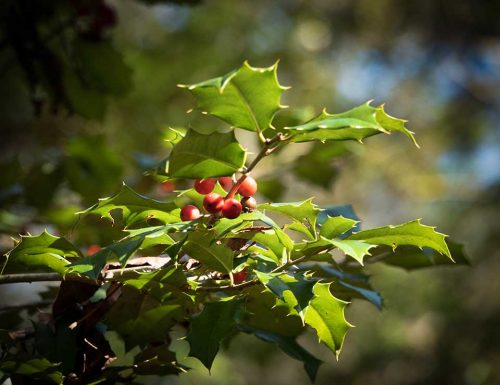 The popularity of holly to modern times remains associated with Christmas, dating back to these pagan roots. When the English and Europeans came to eastern North America the holly they found here reminded them of English holly (Ilex aquifolium), and the decorating continued. The English began using Christmas trees circa 1840, adding to or replacing holly decorations.
The popularity of holly to modern times remains associated with Christmas, dating back to these pagan roots. When the English and Europeans came to eastern North America the holly they found here reminded them of English holly (Ilex aquifolium), and the decorating continued. The English began using Christmas trees circa 1840, adding to or replacing holly decorations.
Folklore suggested that the prickly leaves on holly were the crown of thorns worn by Christ, and the red berries were his blood. This is fancy, not fact. Historians believe that the likely crown worn by Jesus was in fact ziziphus spina-christ, an evergreen tree or plant native to Africa and to southern and western Asia.
There are 450 species in the Aquifoliaceae or holly family; all are of the genus Ilex. There are records of Aquifoliaceae having existed worldwide for 90 million years, and these species are found on all the continents with the exception of Antarctica. The plant native to New Jersey is Ilex opaca or American holly.
American holly grows from the coastal forests of Massachusetts, in the coastal plain through New York, New Jersey, and Delaware (Delaware’s State Tree), and to scattered areas of southeast Pennsylvania. Then its range continues in the Piedmont and Appalachian mountain systems to central Florida. Holly is also present in Gulf states to east Texas. Highly adaptable, growing in nearly sterile soils as well as rich bottom lands, it tolerates many different moisture levels. Since it is susceptible to above-ground damage from fire, larger specimens in southern New Jersey tend to be on the edges of pine forests in swampy areas.

Ilex opaca can grow as a shrub or a tree, primarily depending on conditions. An evergreen, it flowers from May to June. Holly are polygamo-dioecious, meaning there are both male and female trees. Only the females bear fruit, which is called a drupe because it has a central stone or seed, like a cherry or olive.
More than 13 species of birds eat holly berries. Once a person asked me whether birds can get drunk on holly berries, suggesting that she had inebriated robins in her backyard. The answer to the question is, apparently, yes. Dan Fenton, Jr., whose father was the world-famous propagator of holly varieties, said that when he worked at Millville’s famous Holly Orchard robins would sometimes get loopy from eating the fruit. But don’t get any clever ideas; holly berries are mildly toxic to humans, causing vomiting and/or diarrhea.
Birds that especially enjoy hollies are robins, cedar waxwings, and mockingbirds. The United States Department of Agriculture cites ecologists Miller, J.H. and K.V. Miller 1999 as a source for rating species use of various plants. Holly was rated low for large and small mammals and terrestrial birds, making up only 5 to 10 percent of these creatures’ diet. However I would argue that in winter, when food sources are less abundant, it could be an important component of their daily fare.
Holly wood is one of the whitest of known woods, used for chess pieces, piano keys (dyed black and used in place of ebony), broom handles, household furniture, turned objects, and inlays; carvers like the wood. A woodworker’s network describes it as weighing “thirty-eight pounds per cubic foot, typical for many hardwood species.”
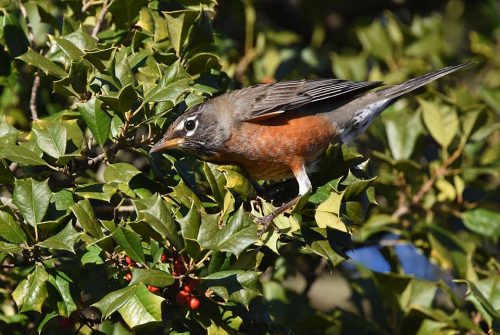
In the past, herbalists and physicians made use of this plant. English holly was brewed in teas to promote sweating and prescribed for fever-inducing illnesses like malaria. Berry juice, though very toxic, was used as a treatment for jaundice. Native Americans used native holly in a tea known as “black drink,” as a cleanse in ritual purifications. Cherokee used it as a gastrointestinal aid, where berries were chewed for colics and dyspepsia. Leaves were used to scratch cramped muscles. Choctaw and Alabama tribes made bark washes for sore eyes. The Koasati employed bark rubs for itchy skin. But let me be clear: The tree has toxins just as do many of today’s powerful modern medicines, and in unskilled hands such “remedies” can be lethal.
In New Jersey American holly generally reaches 40 to 50 feet, but in the best of conditions it can grow up to 80 or 100 feet. Holly shows up in a later successional stage in our forests, coastal dunes, and barrier islands, meaning that if you have a field and it is left to grow, hollies are not generally the earliest of plants that appear. It is abundant in our coastal plain and also in the hardwood swamps of the Pine Barrens.
For me holly is one of the loveliest of trees in the winter. At this season it is loaded with drupes/berries, just waiting for you to enjoy its beauty along the trails of New Jersey’s wild areas. I suppose it’s in your neighborhood yards as well. Merry Christmas and Happy Holidays!
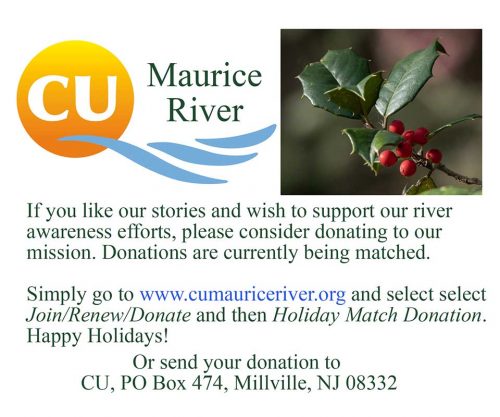
Sources
United States Dept. of Agriculture Fact Sheet, “American Holly,” H. E. Grelen
Delaware State University, Arboretum Education (arboretum.desu.edu)
New Jersey’s Native Trees, Shrubs &
Vines That Are Beneficial to Birds, by Patricia Sutton
KeimLumber.com
Woodworkingnetwork.com
Native American Ethnobotany, Daniel E. Moerman







